In this blog, we’ll look at some different types of crayfish out there. We’ll go in-depth on the details of eight well-known crayfish and one not-so-well-known crayfish. Number seven on the list is pretty crazy. We’re talking lab experiment gone wrong or something.
How Many Types of Crayfish are There?
Crayfish can be found all throughout the world. There are 530 different species of crayfish. That’s a good bit. These crayfish fall into three families: Astacidae, Cambaridae, and Parastacidae.
Some pretty interesting facts about crayfish are:
- After they shed their exoskeleton (molt), they eat the exoskeleton to regain strength.
- They can regenerate claws and other body parts.
- The marmorkrebs is a self-cloning crayfish that produces already fertilized eggs.
- Crayfish live on every continent except for Africa and Antarctica.
- The Blue crayfish (Procambarus alleni) is the rarest crayfish.
Below are nine types of crayfish. Some are well-known for their beautiful colors, while others are known for their disease and the destruction they can bring to the ecosystem.
1. Blue Crayfish
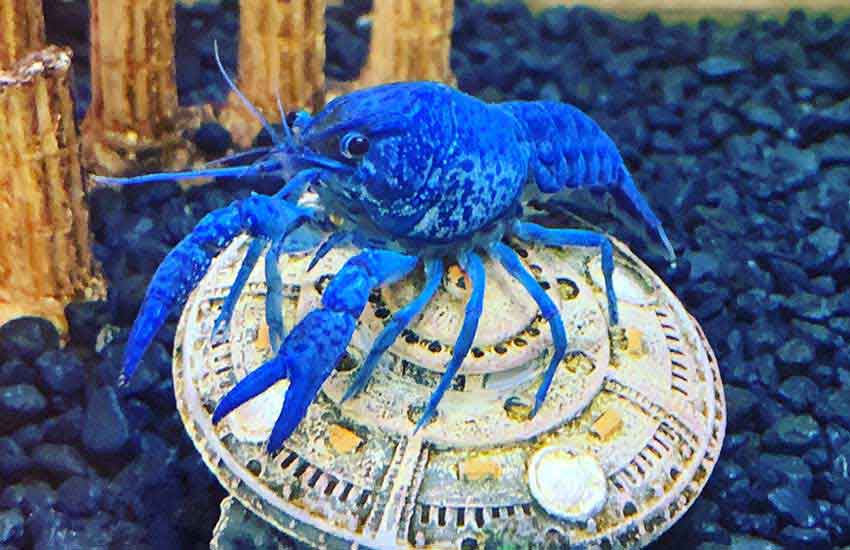
Indigenous to Florida, the blue crayfish (procambarus alleni) can be found in the St. John’s River and on down into the keys.
Blue crayfish are the rarest of all crayfish and are highly sought after by many aquarists because of their stunning blue color. Their electrifying blue color is the result of a genetic defect. Although, many often wonder if their color is artificial. Nope, it’s all real.
Like most crayfish, the blue crayfish is very territorial and aggressive. The blue crayfish, like all others, is an omnivore and a scavenger.
In the wild, they eat live and dead fish, worms, larvae, and decaying plant matter. When kept in captivity, blue crayfish can be fed sinking algae pellets, brine shrimp, bloodworms, and vegetables like zucchini and cucumber. These crayfish aren’t picky eaters.
Blue crayfish grow to be about 4 to 6 inches long and they have varying lifespans. Depending on the quality of care, they will live between 3 to 6 years, roughly.
2. White Crayfish
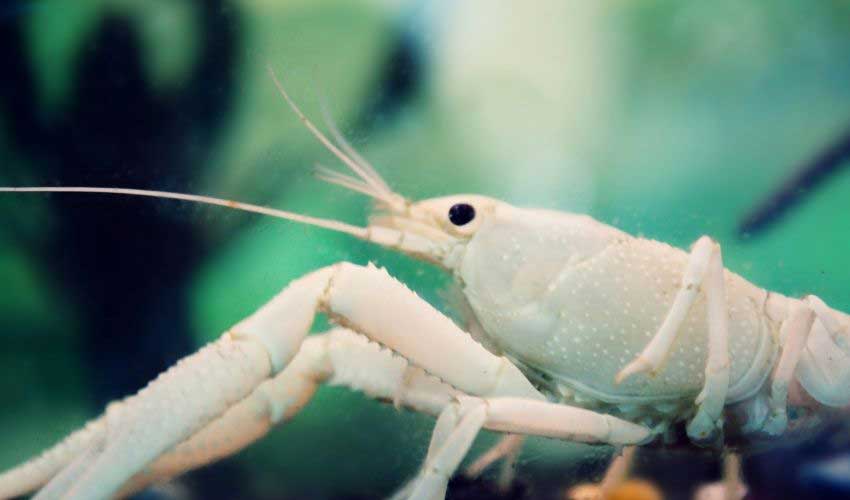
The white crayfish or white specter (procambarus clarkii), is simply a variation of the blue crayfish. These guys are very much related. However, the white crayfish is, well, white.
White crayfish are also native to Florida and have the same temperament, eating habits, and other characteristics of blue crayfish, for the most part. They eat the same things as blue crayfish and are definitely beautiful creatures.
3. Mexican Dwarf Crayfish
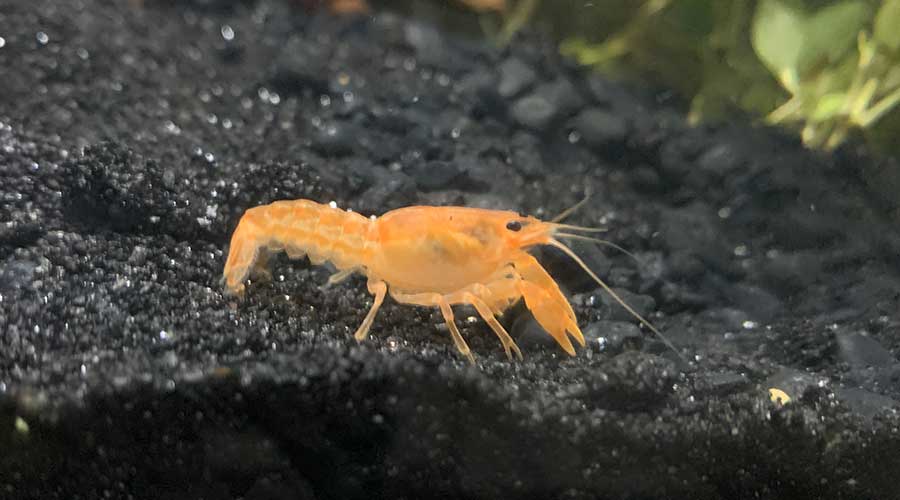
The Mexican dwarf crayfish is a tiny little thing. It only grows to be about 1.5 to 2 inches. The Mexican dwarf crayfish is, of course, from Mexico, Lake Pátzcuaro to be specific.
Now, these guys are crayfish, of course. However, their temperament varies a bit from other crayfish. Although territorial at times, many aquarists find that these crayfish aren’t as aggressive as others.
Mexican dwarf crayfish can live in community tanks with other freshwater fish. I keep mine in a 20-gallon planted tank with a german blue ram and some corydoras. And, he has yet to destroy my plants or kill a fish. Let’s see what happens though.
However, make no mistake about it, if he could catch and kill a fish, he certainly would. But, he’s a little guy. For the most part, he just stays hidden behind a rock in my tank or hangs out in the plants only to surface during feeding time. He’s definitely different than the blue and white crayfish I’ve kept in the past. He’s much friendlier it seems.
This little crayfish is an omnivore like all of the others. For food, he will eat what the rest of them eat: sinking algae pellets, brine shrimp, bloodworms, and veggies. He’ll also eat dead and decaying plant matter in a fish tank. He’s great for clean-up.
Mexican dwarf crayfish don’t live as long as other crayfish like blue and white crayfish. These crayfish usually only live for 2 to 3 years.
4. Blue Dwarf Crayfish
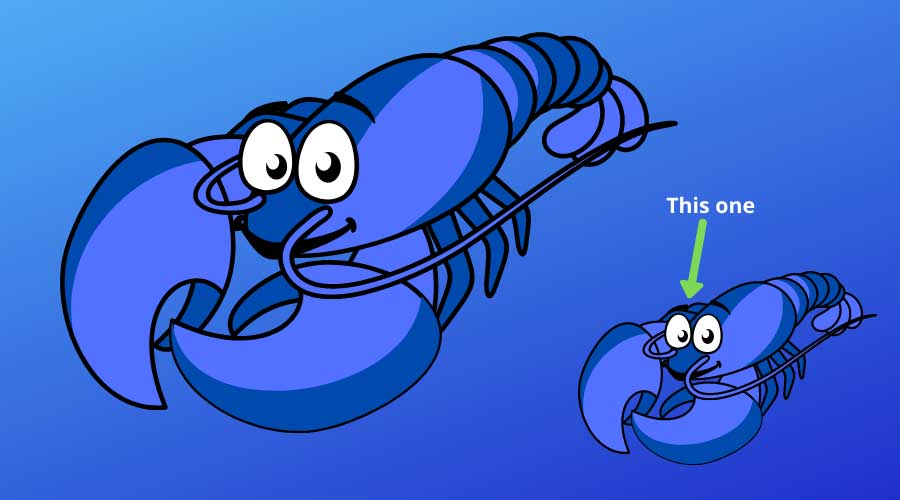
Dwarf blue crayfish are a selectively bred variation of another crayfish that is indigenous to the Southeastern parts of the United States. In nature, you’ll usually find that this crayfish is an earthy gray or brown color.
These types of crayfish, like Mexican dwarf crayfish, tend to be less aggressive and can be kept in community fish tanks.
These crayfish grow to be about the same size as a Mexican dwarf crayfish, 1.5 to 2 inches. They also have a short lifespan of 1.5 to 3 years.
If you plan on keeping one of these crays, don’t mistake it for the bigger electric blue crayfish. Their temperaments are distinctively different.
While dwarf blue crayfish are known to be peaceful and great for community tanks, electric blue crayfish are way more aggressive. And, although electric blue crayfish can be kept with select fish, they can’t be kept in just any community tank.
5. Cherax Destructor
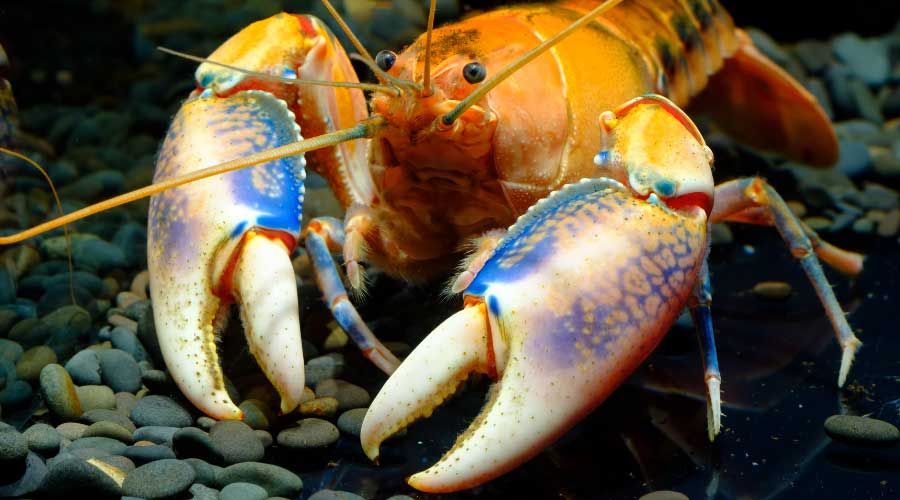
The cherax destructor (the common yabby) is a pretty but intimidating-looking crayfish. Look at the size of those claws. He must lift weights.
These types of crayfish are native to Victoria, New South Wales, and Southern Queensland, in Australia and are found in muddy waters. They are extremely aggressive and territorial omnivores. They are also an invasive species.
Other than being “destructive,” the cherax destructor is known for hibernating and digging itself under the mud.
In the wild, the cherax destructor eats snails, tadpoles, live and dead fish, and plant matter. In captivity, the yabby can be fed sinking algae pellets, frozen brine shrimp. frozen bloodworms, and a variety of vegetables. As crayfish, they aren’t exactly the pickiest eaters.
The cherax destructor grows to be pretty big at roughly 6 to 8 inches in length. These crayfish live for 6 to 8 years, which is a fairly long time.
PRO TIP: This is one that you definitely do not want to keep in a tank with plants. They will flat out destroy them. This is actually a risk you take with most any other crayfish in a planted tank.
6. Red Swamp Crayfish
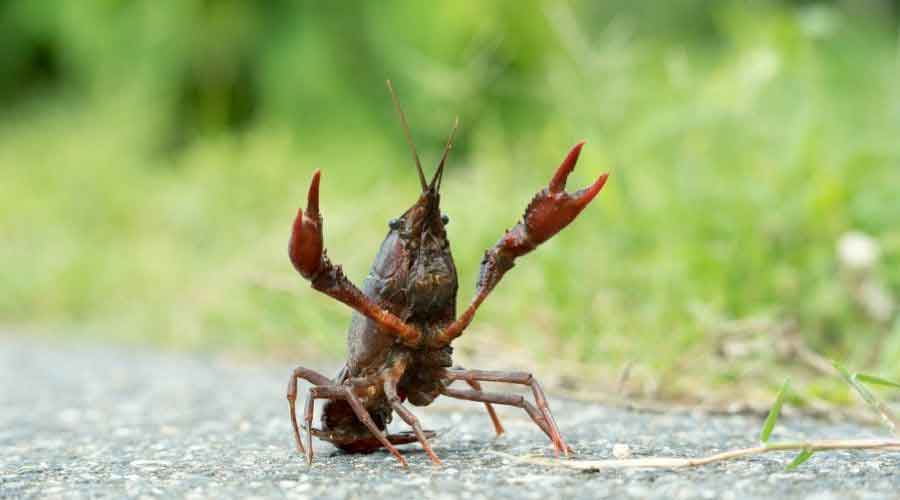
When you think of a crayfish, you probably think of the red swamp crayfish (Procambarus clarkii). Red swamp crayfish can be found in the colors red, orange, and reddish-brown.
The red swamp crayfish is from Louisiana. They are extremely aggressive. They’re also considered an invasive species and can wreak havoc on an ecosystem. This is because they eat virtually everything they can get to in the wild.
In the wild, red swamp crayfish feed on snails, larvae, tadpoles, live and dead fish, and plant matter. In captivity, these crayfish enjoy the same diets as other crayfish, sinking algae pellets, frozen brine shrimp, bloodworms, and anything they can get to.
Red swamp crayfish are known for carrying parasites and crayfish fungus plague. These are the types of crayfish you don’t want to just pick up and throw into the home aquarium.
Red crayfish grow to be between roughly 2 to 5 inches in length. They live for 2 to 5 years.
7. Tangerine Crayfish
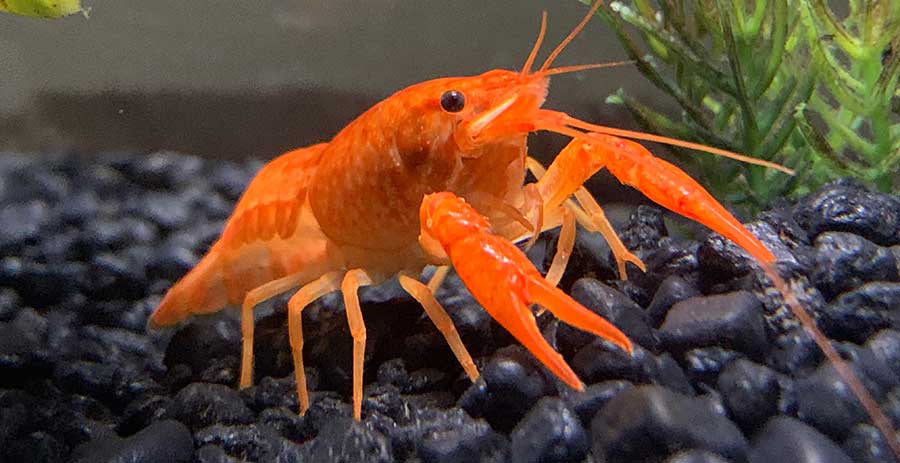
The gorgeous tangerine crayfish (Procambarus clarkii). I have kept one of these types of crayfish over the years. They have a beautiful bright orange color. But, don’t let their beauty fool you. These guys are crayfish and are still pretty aggressive and territorial. I’ve seen one take out a pea puffer fish.
Tangerine crayfish are from the Southeastern parts of the United States. Like all of the other crayfish, these guys are omnivores. If you get a tangerine crayfish as a pet, he’ll be happy eating sinking algae pellets, frozen brine shrimp, frozen blood worms, and frozen vegetables.
The tangerine crayfish grows to be about 2 inches in length and lives for about 2 to 3 years. Don’t mistake these crays for the Mexican dwarf crayfish. They’re not exactly community tank crayfish.
8. The Million Baht Crayfish
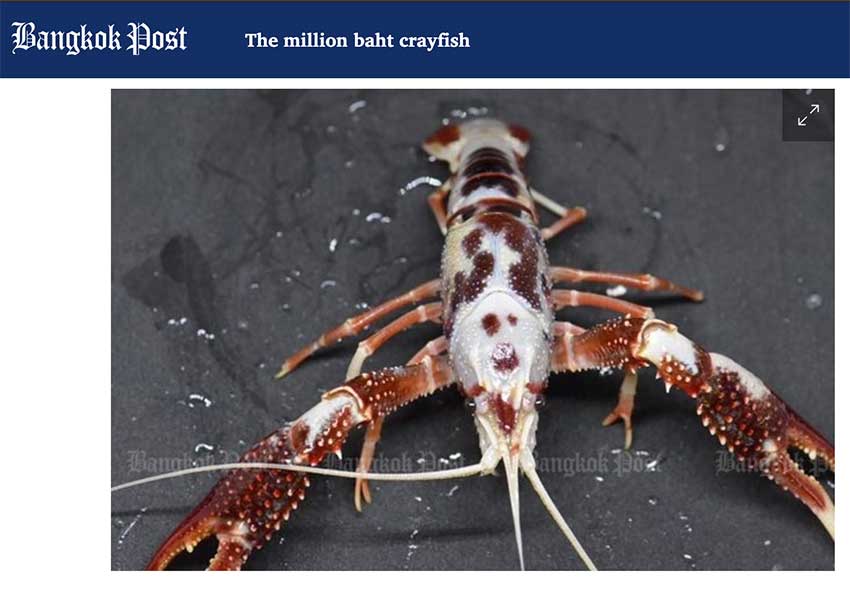
Just for fun, the last crayfish on the list is known as the “million Baht crayfish.” It is a crayfish that was bred in Thailand by Nakhon Pathom.
The crayfish’s name is Chao Khun Chang. And, this million Baht crayfish is an ornamental procambarus clarkii ghost crayfish. It is a type of crayfish that was developed by Kanokphum Siriwat, a man who spent the time creating his own signature crayfish.
The buyer, Prathan Lianpanich, became obsessed with the crayfish after seeing its color. Pathom initially turned down two of Prathan’s previous offers before letting this rare crayfish go for one million Baht.
Keeping Different Types of Crayfish as Pets
Keeping crayfish in an aquarium can be a really fun hobby. However, there are many things that anyone wishing to keep crayfish should take into account. For one, the tank set up for crayfish.
I recommend keeping one full-size crayfish (non-dwarf) in at least a 20-gallon fish tank. Consider sand or small gravel substrate and shoot for a pH between 7 and 8 with a water temperature of 70 to 75 degrees.
With dwarf crayfish, you can get away with tanks as small as 5 and 10 gallons. But, personally, I’d suggest bigger tanks even for the dwarf crayfish as you’ll probably want to keep your crayfish with other freshwater fish, more on that in a minute.
When keeping crayfish, especially full-size crayfish, you have to consider which types of freshwater fish you are going to keep as tank mates. In short, you want fish that swim in the top to the middle of the tank. With dwarf crayfish, however, these crays can do well in community tanks.
Plants can be a controversial topic when it comes to keeping crayfish. In keeping full-size crayfish like blue crayfish and others, I’ve seen that they can be very destructive towards plants. However, with dwarf crayfish, like the Mexican and blue dwarf crayfishes, plants can work well. For dwarf crayfish, these provide great hiding places.
With every crayfish, it’s imperative that you provide them with hideouts. Hideouts can consist of rocks, driftwood, or even be homemade out of PVC pipe. It’s important that crayfish are given hideouts because, for one, they like to burrow. Also, crayfish need a place to hide during and after molting. This is a time when they become weak and very vulnerable to other life in the tank.
Types of Crayfish: A Review
There are 530 different types of crayfish throughout the world. And, many aquarists seek blue crayfish, Mexican dwarf crayfish, and others to keep as pets.
Crayfish are omnivores and love to eat both plant-based and meat-based foods. With the exception of dwarf crayfish, most crayfish are aggressive and territorial. And, they can’t just be kept with any freshwater fish. This is because they will kill them if they get the chance and eat them.
Crayfish like the red swamp crayfish and cherax destructor are a bit of a nuisance as they are invasive and destructive. They also are known for carrying disease. And the marmorkrebs is a mysterious self-cloning crayfish.
If you plan on keeping crayfish, again, always remember to be mindful of tank size and tank mates as the larger crayfish will attack, kill, and eat fish that swim on the bottom of the tank. However, there are a few exceptions.
Our Recommendations
